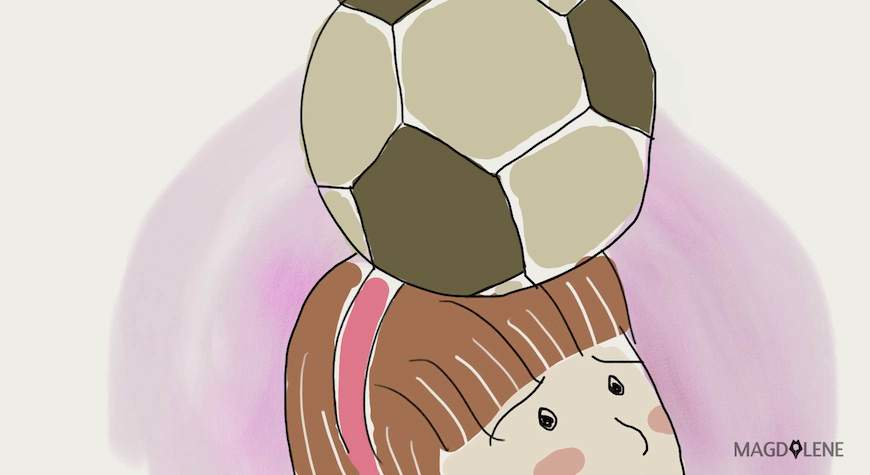If you’re not into football, that is fine. I have two bros who don’t see the point of football.
“Twenty two grown-ups chasing a ball for 90 minutes. That’s pretty mature,” one of them said.
Feminists and progressives, though, followed the 2015 FIFA Women’s World Cup in Canada with a passion, as it's a showcase of women’s empowerment in a sport long closely associated with manhood.
Certainly women had kicked ball for as long as men had, particularly the court ladies in ancient China and medieval European townies. British ladies played football during the First World War, leading to a ban on women from playing in 1921 by the English Football Association. Fifty years later, European football associations finally approved of women’s football games and leagues. The rest of the world has since followed.
Indonesian women did pretty well long time ago. In the 1977 Asian Cup we reached the semifinal, a feat that was repeated nine years later. The result did not translate into a much-deserved appreciation, however. The development of women’s football in Indonesia has remained neglected, amid live broadcast of European leagues and the creation of the Indonesian Super League in the 1990s.
The first FIFA Women’s World Cup was held in China in 1991 and throughout the 1990s, the strongest nations were Germany, Brazil, Sweden, Norway, United States, and China. A majority of them did not have fearsome men’s national teams and so the pattern of international women’s football was set. It seems able to flourish in countries where women’s participation in grass root and semi-professional sports is appreciated – meaning there are enough money and official support – which is not the case for Latin countries in America and Europe.
Japan won the 2011 Women’s World Cup in Germany, against some odds. Although Japan certainly has the money and the facilities, it has few female footballers. The L. League is among the oldest in the world, but, like elsewhere, the semi-professional players have to have day jobs and be content with playing in empty fields. So how could Japan achieve a better result than Spain, Brazil, or China? One word: investment.
The club owners (either corporations or municipal governments) are willing to invest in the development of the players, turning the small pool of women footballers they have into highly fit and skillful athletes. L. League clubs and Japanese Football Association send their teams to train in United States and Australia, and Japanese best footballers play in European and American leagues.
Also, while East Asian nations are very patriarchal, they don’t have a macho culture, so Japan faces neighbors that are also building strong women’s football teams – China and the two Koreas. Instead of mocking women playing football, East Asian crowds give full support for their team (at least during matches) in the name of nationalism.
The 2015 World Cup is not the first one held in the era of Twitter and online journalism, but unlike in 2011, real time commentary on current events has reached a global scale. 4G mobile connection and free Wi-Fi everywhere has enabled people worldwide to have their say on any breaking news at the same time. Also, in 2011 debate on feminism and LGBTQ+ had not reached the mainstream media.
You might have read or commented on some of the issues surrounding the women’s World Cup. How several players sued FIFA and Canadian Soccer Association for choosing artificial turf, which increased ground temperature and the risk of injury. How Australian media still ignored the tournament, even as the Matildas reached quarterfinals. How the triumph of Asia went together with the agony of African football. How machismo let down the Mexican and the Spanish national teams (Argentina and Italy didn’t even pass the continental qualification).
The final match between United States and Japan, repeating the 2011 final, broke TV viewers’ record. Twenty-seven million Americans were thrilled as they watched the United States crushed Japan 4-0 in 16 minutes, leading some to exclaim “Pearl Harbor!” – to the ire of Asian-Americans. The biggest controversy of the day, anyway, was made by the English FA, which welcomed the triumphant English players as returning “mothers, partners, and daughters” (at least they did not say “wives or girlfriends”). Conservative newspaper Daily Mail deliberately mocked negative responses to the deleted tweet by denigrating the English team (and the cup) further.
So this is the beginning of the journey. And struggle. Like women in many other fields, female footballers are alternately judged as ugly hags and/or sexy babes. As shameless lesbians and/or good wives and mothers. As heroes of the nation and/or flavor of the month. And they are still paid less than male footballers of equivalent rank. It’s roughly the same story for female athletes in other sports.
Televisions do not rush to secure the broadcast rights of American, Japanese, and English women’s leagues, but, fortunately, I can play as Kadeisha Buchanan, Celia Sasic, and Carli Lloyd, when FIFA 16 video game comes out in September, featuring a dozen of women national teams (not including Japan, due to licensing issue). You bet the news triggered some angry reactions, and more is expected to come in upcoming months.
Other challenges prevail: how to encourage diversity in the sport. Some teams are more multiracial than others, and this is not purely coincidental. The road to become a professional footballer is still too expensive for a black or Latina American (soccer is still a middle-class suburban sport), and the persistence of racism in Japan would make it harder for a Korean-Japanese or Okinawan girl to dream of playing for Japan.
If more money and media coverage are given to the American and English leagues, we will have to face the dark side of success: gamesmanship, greed, and controversial players. But before that, we have to pass the phase when women’s football is taken seriously by countries like Spain and Chile. In the meantime, I would laugh out loud if a Southeast Asian man dares to describe women’s football as “boring and lousy”. Check your men’s football first.
*Read Mario’s take on feminism on games and sexism and follow @mariorustan on Twitter.









Comments